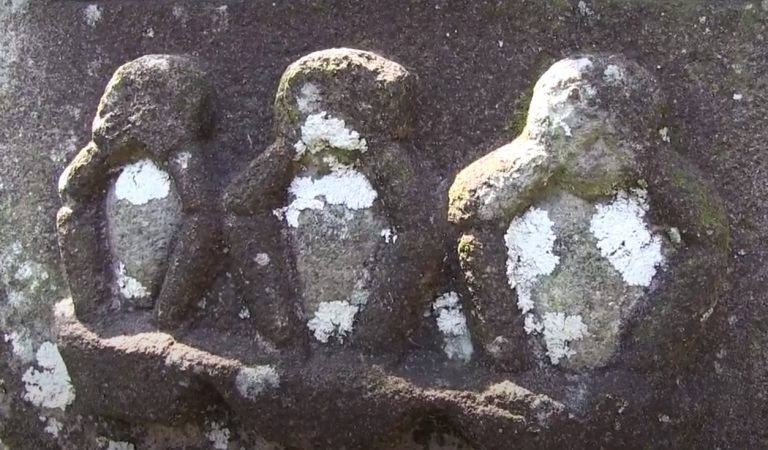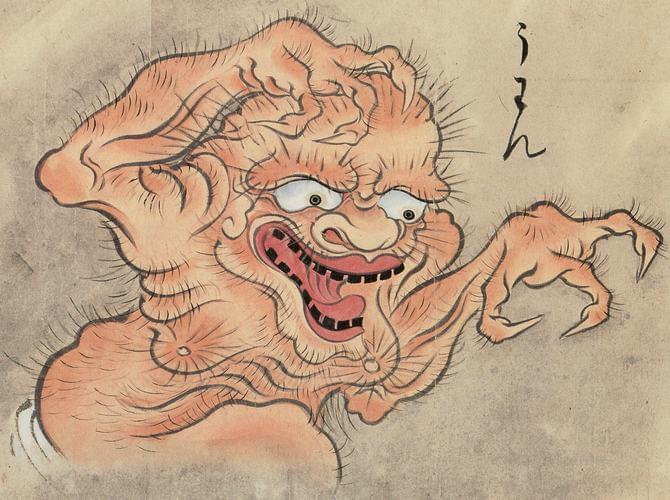Introduction
Hey hey, my name is Thersa Matsuura author of The Book of Japanese Folklore and podcaster here at Uncanny Japan. Here I tell you about the more obscure nooks and crannies of Japanese culture.
In today’s episode, I’ll be taking you on a journey to visit the Golden Pavilion. Kinkakuji is arguably one of the most well known temples in Kyoto or all of Japan really.
So what do you know about it? When did you first hear about it? Did you know some people swear that you can take some photos of pretty out of the ordinary ghosts when you visit? Me neither. So I sat down and made a list of things I did know about this iconic Zen temple and realized despite having visited many times, I really didn’t know much at all.
The True Name of the Golden Pavilion
Let’s start with the fact that its real name isn’t even Kinkaku-ji. That’s more of a nickname. I’ll back up a minute. Before the Golden Pavilion was a temple, it was a villa owned by a statesman and was called Kitayama-dai. In 1397, the Shogun Ashikaga Yoshimitsu (1358-1408) acquired it and made it into a beautiful complex. It still wasn’t legitimately a temple yet. He wanted that to happen, but before it could, poor old Yoshimitsu passed away. His son, though, followed through with his father’s dream and turned it into a Rinzai Zen temple.
The official name, however, wasn’t and isn’t Kinkaku-ji – The Golden Pavilion. Here’s some trivia to impress your friends with. In Japan, people are given posthumous names after they die. Special Buddha names, different from the one you used when you were alive. They’re called Kaimyō or “precept name” and there are several reasons for giving and getting one of these names after death. One of those reasons is that it’s kind of like, when you die and you show up (hopefully) in Buddha’s paradise you’ll be recognized as a disciple and welcomed. A little snarky and funny side note: they are given by Buddhist monks and cost quite a bit. The more you pay the “better” name you get. Some people rightly think that’s not fair. The richer you are the better position you get in heaven. However, even though this is a centuries old tradition I see things changing a little. I had an older friend who was very well read and loved old Japanese and obscure kanji. His hobby (he called it) was that he would actually come up with beautiful kaimyo for friends and family who needed one to use, totally free.
Anyway, Yoshimitsu was given the name Rokuon for his posthumous name. It means “Deer Park”. Really Deer Park. It came from the place the Buddha gave his first sermon after he attained enlightenment: Deer Park. So the temple everyone calls Kinkaku-ji, is really named Rokuon-ji – Deer Park Temple. If you’re ever on Jeopardy…
Another bit of trivia is that it used to be taller. At one point it was a five-tiered pagoda, but in 1416 it was struck by lightning and burned to the ground. It started to be rebuilt and Bang! It was once again struck by lightning and burned down again. I’m not sure, but I think it was then that it was built only three stories tall.
Those lightning strikes aside, when the Onin War took place in 1467 to 1477, the army came through Kyoto and burned down just about everything. This time all the other buildings around Kinkakuji got torched, but the Golden Pavilion itself survived.
Architecture and Design
The Golden Pavilion you see today is not so big and consists of three floors, each one in an entirely different architectural style. The first — which also isn’t covered in gold at all — is called Hōsui-in or The Chamber of Dharma Waters (Dharma being the Buddha’s teachings). Its style is from the Heian Era (11th century) called Shinden style. You can’t go inside, but if you could, you’ll find it’s all one big room but with a little raised area where the restored statue of Ashikaga Yoshimitsu and the Shaka Nyorai Buddha sit side by side. The ceiling is made of mirrors.
The second floor goes by the fancy name of Chō on dō or Tower of Sound Waves. It’s built in the style of samurai families, called Bukke. It has black lacquer walls and ceiling with celestial deities painted flying around. The outside is covered in gold leaf. And the third floor is built in Chinese style and both inside and outside are covered in gold leaf.
Another thing I didn’t know is that it’s used as a shariden, meaning it houses some of the Buddha’s ashes. Side note: The rice part of your sushi, the little block the fish or egg or whatever rests on, is called a shari in Japanese. This comes from shariden because if you look at the Buddha’s ashes or actually small bits of bone, they look like grains of rice.
The 1950 Arson Attack
So lets fast forward to the Golden Pavilion in the 20th century. Specifically, July 2nd, 1950. On this night at three am, all the beauty was completely destroyed once again. This time by a novice monk associated with the temple who decided to burn it down. The entire building was consumed as were the priceless Buddhist relics and artwork housed inside, some were restored though.
This young monk, who let’s say had a complicated life, was found nearby. He had attempted to take his own life by taking barbiturates and cutting his stomach, harakiri. Note that the ritualistic form of disembowelment is called seppuku. Harakiri is a grosser form of the act. It’s said harakiri is the actual act and seppuku would be the ritual. Also, seppuku involves a kaishakunin, a kind of assistant — usually the samurai’s second or retainer — who stands with his sword ready to deliver a final decapitating blow, ending his master’s suffering.
Let’s go back to the young monk. After his arrest, he was sentenced to seven years in prison. He gave his reason for destroying the Golden Pavilion as a desire to shock society and revenge against the world. The author Yukio Mishima wrote a novel called The Temple of the Golden Pavilion, which was a fictionalized version of the arson attack. He even visited the young man in prison to interview him. The young man ended up getting tuberculosis and died at the age of 26.
In a very ironic twist of fate, it’s a long story, but Mishima himself became extremely nationalistic, started his own private militia, kind of attempted a coup with four of his followers, and ended up committing seppuku for real.
The Phoenix and Reconstruction
Now what to do about the iconic temple though. One lucky thing is that from 1904 to 1906 the whole temple was painstakingly dismantled and rebuilt, carefully repairing all the parts that needed to be repaired. During this endeavor meticulous drawings were made about how it was built. After the 1950s fire, those schematics were used to faithfully restore the beloved Kinkaku temple to its original self. It took over a period of five years. And another – we’ll call it lucky thing – is that before it was set on fire that night in July, there was only gold leaf on the third floor, with none remaining on the second. They decided that with the new version – after the 1950 arson attack – they would use thicker gold leaf and cover both the second and third floor, making it more gorgeous than before. To this day, the view of it reflected in the pond outside is very famous.
If you’ve ever seen a photo of The Golden Pavilion or been there to see it in real life, you’ll notice there’s a golden bird on top. This is — as I’m sure you guessed — a phoenix, called a Hō-ō in Japanese. It symbolizes auspiciousness and is also associated with the imperial family. Some historians suggest the fact that it was placed on top by the ambitious Ashikaga Yoshimitsu, a mere shōgun, meant that he might have harbored ambitions of elevating his lineage to imperial status, and this was a symbol of that connection. True or not we know that phoenixes are symbols of resurrection, particularly after getting burned. This particular mythical bird actually didn’t get burned, though. It survived the 1950 arson attack because it had been taken down for repairs at the time.
There used to be a rumor that the top floor’s ceiling was made from a single piece of camphor wood. Which would be an enormous tree. Sad. But it seems that this isn’t true. But it didn’t stop people from talking about it and flocking to visit. Even though they couldn’t even go inside to check it out for themselves.
Unusual Ghost Stories
Another thing I find interesting about Kinkakuji is that in Japan usually every old building, temple, shrine, crossroad, bridge, tunnel, phone booth, or public toilet has some sort of ghost story connected to it. It’s kind of inevitable.
But I couldn’t find anything about any bad or vengeful ghosts associated with the beautiful Golden Pavilion. That doesn’t mean I didn’t find ANY ghost stories. I did find that there are urban legends that say you *can* capture ghostly images if you take a photo of the temple, but they aren’t the wicked kind. They all seem to me bald headed monks, wearing fundoshi loin clothes with their hands in prayer or engaged in some other acts of austerity. I’m not sure Kinkakuji was ever a place for such practices, but teenagers have wonderful imaginations and Kinkakuji is one of the must visit temples for school trips from all over Japan. So quite a few people have reported capturing ethereal images of these ascetic monk spirits. Some are swimming in the pond, others sitting zazen on the roof, and even lying on the roof and sunbathing. Which kind of makes you want to go take some photos.
Closing Notes
Okay, that’s all for today. Thank you so much for listening. Please consider becoming a patron, if you’d like. I’m reading through The Pillow Book at the moment for patrons only and it’s a lot of fun.
Bye bye, talk to you in two weeks.






